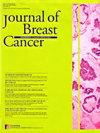COVID-19大流行时代新发乳腺癌患者影像学检查的最佳时机
IF 2.2
4区 医学
Q3 ONCOLOGY
引用次数: 0
摘要
我们的研究是对新诊断的癌症患者的回顾性研究,这些患者在2021年4月至2021年9月期间在同侧手臂同时接种了2019冠状病毒病(新冠肺炎)疫苗,并接受了腋窝淋巴结活组织检查或手术。在我们的研究人群中,最近一次疫苗接种和影像学评估之间的中位间隔为26天(范围为4-49天)[1]。先前的报告表明,淋巴结病最早可以在第一次给药后一天发生,最有可能在14天内出现。然而,新冠肺炎疫苗相关淋巴结病的解决时间各不相同,在疫苗接种后43周内观察到持续性腋窝淋巴结病[3]。此外,患者和疫苗因素,如年龄较小、第一剂和信使核糖核酸疫苗类型,会导致腋窝淋巴结病的发病率较高[4]。本文章由计算机程序翻译,如有差异,请以英文原文为准。
The Optimal Timing of Imaging Examinations in Patients With Newly Diagnosed Breast Cancer in the COVID-19 Pandemic Era
Our study was a retrospective study of patients with newly diagnosed breast cancer, who received concurrent coronavirus disease 2019 (COVID-19) vaccination in the ipsilateral arm, and underwent biopsy or surgery for axillary lymph nodes between April 2021 and September 2021. In our study population, the median interval between the most recent vaccination and imaging assessment was 26 days (range, 4–49 days) [1]. Previous reports have indicated that lymphadenopathy can develop as early as one day after the first dose, and is most likely to be seen within 14 days. However, the time to resolution of COVID-19 vaccine-associated lymphadenopathy varies, with persistent axillary lymphadenopathy observed up to 43 weeks post-vaccination [3]. In addition, patient and vaccine factors such as younger age, first dose, and mRNA vaccine type induce a higher incidence of axillary lymphadenopathy [4].
求助全文
通过发布文献求助,成功后即可免费获取论文全文。
去求助
来源期刊

Journal of Breast Cancer
医学-肿瘤学
CiteScore
3.80
自引率
4.20%
发文量
43
审稿时长
6-12 weeks
期刊介绍:
The Journal of Breast Cancer (abbreviated as ''J Breast Cancer'') is the official journal of the Korean Breast Cancer Society, which is issued quarterly in the last day of March, June, September, and December each year since 1998. All the contents of the Journal is available online at the official journal website (http://ejbc.kr) under open access policy. The journal aims to provide a forum for the academic communication between medical doctors, basic science researchers, and health care professionals to be interested in breast cancer. To get this aim, we publish original investigations, review articles, brief communications including case reports, editorial opinions on the topics of importance to breast cancer, and welcome new research findings and epidemiological studies, especially when they contain a regional data to grab the international reader''s interest. Although the journal is mainly dealing with the issues of breast cancer, rare cases among benign breast diseases or evidence-based scientifically written articles providing useful information for clinical practice can be published as well.
 求助内容:
求助内容: 应助结果提醒方式:
应助结果提醒方式:


